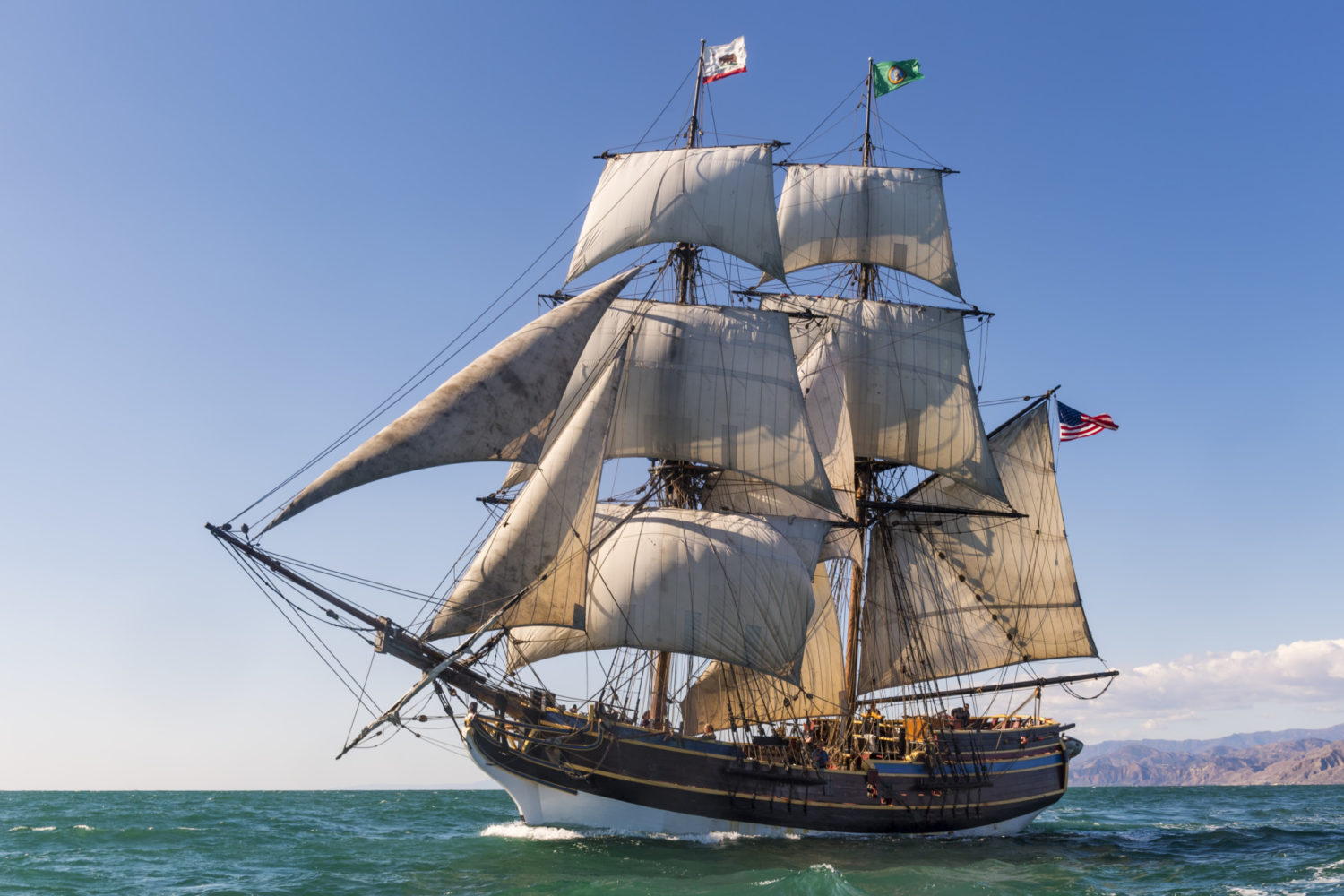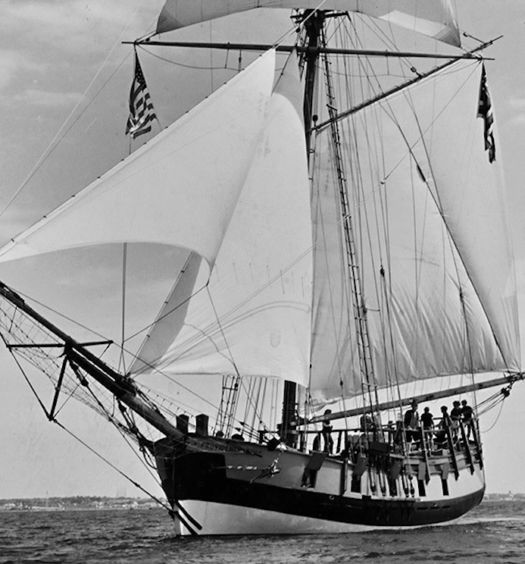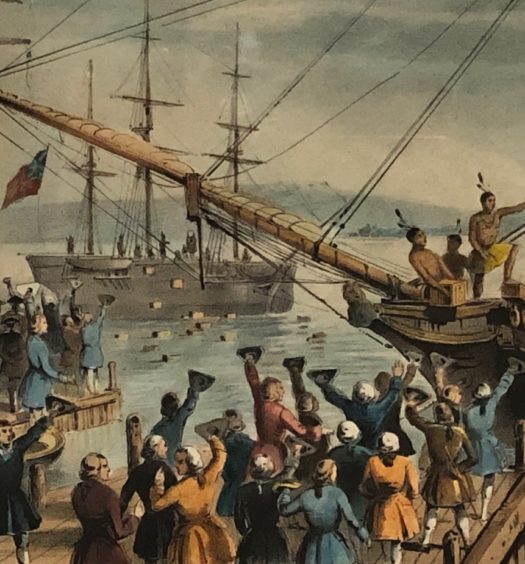Stanton Hazard was born on January 8, 1743, into the prominent Hazard family of King’s (later Washington) County. He moved to Newport and, as with many young men, he took to the sea. Soon he gained a commission as a lieutenant in Britain’s Royal Navy (another Newport lieutenant in the Royal Navy at the time was Jahleel Brenton; Brenton was offered the job of head of the Continental Navy in December 1775, but he politely turned it down and continued in the Royal Navy long enough to become an admiral). According to a circa 1763 portrait of Hazard in naval uniform, painted in Rome (probably by the studio of the famous Pompeo Batoni), he achieved a rank of lieutenant in Great Britain’s Royal Navy by the end of the Seven Years War in 1763. Although Hazard is not listed in Professor David Syrett’s list of all Royal Navy officers in historical times, the punishment for impersonating a naval officer was severe enough that we can be sure that the portrait is proof of his service.
As a 20-year-old lieutenant, he was likely not to have gained much useful experience. Only a very few lieutenants were retained in the navy in peacetime, so he did not have any more military experience working for the Royal Navy for the next twelve years. He sailed as a commercial captain during that time out of Newport.
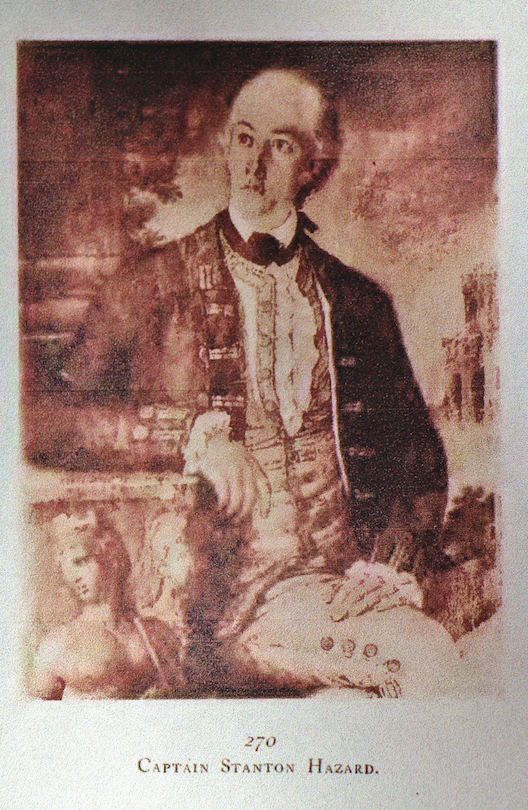
Black-and-white copy of the painting by Pompeo Batoni of Stanton Hazard, wearing the uniform of a Royal Navy officer, in Rome (Hazards of Rhode Island, 1635-1896)
With the onset of the American Revolutionary War, Hazard offered at age 32 to join the Continental Navy established in October 1775 and managed by a committee of the Continental Congress in Philadelphia. Even his limited experience was likely to be enough for him to claim a promotion to commander in the Continental Navy (a commander was someone deemed capable of commanding any warship of eighteen guns or fewer). By the time his offer was received, all the billets for commander (six) and captain (three) had already been filled. All the Continental Navy had available was the rank of lieutenant, a rank that John Paul Jones, an experienced civilian sailing captain then living in Fredericksburg, Virginia, was happy to accept at the time.
One man already hired as a commander in the Continental Navy was Stanton’s likely cousin John Hazard of King’s County, who does not appear in the genealogical book The Hazards of Rhode Island, 1635-1896. His non-appearance in that book is most likely an oversight, as everyone with the surname of Hazard in Rhode Island was almost certainly related to the original Hazards. Thomas Hazard and his family arrived in Boston in 1635 (just a year after the Rev. William Blackstone and his 25 followers had been forced to leave Boston, whence they founded Rhode Island two years before Roger Williams!), moved to Portsmouth on Aquidneck Island in 1638, and helped to found Newport in 1639. John Hazard, who later in the war resided at Little Rest (now Kingston), was placed in command of the 12-gun Rhode Island-built sloop Providence (formerly known as Katy). He took command of the sloop in Philadelphia as 1775 turned to 1776. (Note: the author was the driving force for the construction of a full-sized, operational reproduction of the sloop Providence, completed in 1976; she is now scheduled to be based full-time in Alexandria, Virginia).
The experienced commander from Philadelphia, Nicholas Biddle of the Continental Navy’s Andrew Doria, who had served as a lieutenant and messmate of Horatio Nelson in the Royal Navy, described John Hazard as “A Stout man Very Vain and Ignorant” and possessing “as much low cunning as Capacity.” Hazard’s crew later complained about Biddle to Commodore Esek Hopkins, the Continental Navy’s commander-in-chief, for beating them with heavy sticks and rope’s ends and keeping them on duty with no time for eating for fourteen hours at a time. “We are used like dogs on Board the Providence. We hope that you will find a new Captain,” complained the petitioning seamen.
The commanding officers of the first eight Continental Navy ships assembled in the great cabin of Commodore Esek Hopkins’s flagship, the 24-gun ship Alfred, on January 10, 1776, and were given three alternative objectives by a representative from Congress: go to Charleston, South Carolina, to protect that city from an expected attack by a large British naval and army force; go to the Chesapeake Bay to defeat Royal Governor Lord Dunmore and a small British naval force there; or go to Rhode Island to drive out the 20-gun frigate Rose and all her consorts, including the 20-gun frigate Glasgow, and the 16-gun corvettes Swan, Nautilus, and Kingsfisher.
Members of Congress, despite previously giving George Washington a lot more power as commander-in-chief of the army, made sure that Commodore Hopkins had almost no power at all as commander-in-chief of the navy. All he was permitted to do was hold meetings of all his commanding officers and get them to vote on what actions to take. Half of his commanding officers were from Rhode Island and one was from Connecticut, so he knew that those officers were likely to vote as a unified block. The officers interviewed intelligence experts, who convinced them that their latest information showed that the American fleet had no chance of defeating the overwhelmingly powerful British fleets approaching Charleston, or in the Chesapeake, or in Rhode Island – and besides, sailing in Rhode Island in January was far too cold for their taste. The officers then developed their own fourth option: go somewhere warm, like Nassau in the Bahamas.
To be fair to them, they had a good reason. The American Revolution would have quickly and completely collapsed without gunpowder. Gunpowder was made from three ingredients: charcoal, saltpeter, and sulfur. The first two ingredients were sufficiently available, but sulfur had to come from volcanoes, and all the volcanoes that anyone knew about were in Italy: Vesuvius, Etna, and Stromboli (conveniently forgetting the walk-in volcanoes on the Caribbean islands of Saint Lucia and Saint Vincent). Therefore, all American gunpowder had to be imported from Europe (particularly France) or captured from the British.
The main British fort at Nassau in the Bahamas was only lightly guarded, but it contained a hefty supply of gunpowder. The fleet sailed to Nassau, arriving early in March 1776. Since the sloop Providence was small enough to get in close to the beach, her Marines prepared to make the first ever amphibious landing by U.S. Marines. However, by the time the marines and sailors had reached the principal fort, which stood over two miles from the beach, they found that the four militiamen guarding it had obtained the help of volunteer townsfolk and they had prudently removed all 162 barrels of the powder beforehand. The powder was put aboard the 6-gun schooner Saint John and another local vessel, which had quickly sailed to the big British fort at Saint Augustine, Florida. The powder would be entirely safe there from American capture.
After they had failed to secure the powder, the American fleet sailed north to New England with a load of rusty 18-pounder cannons pillaged from the forts at Nassau. Some six weeks after the British evacuation of Boston on March 17, they found that the British warships were no longer occupying Rhode Island waters.. This development caused the Rhode Island General Assembly to decide to give the British no legal reason to return to Rhode Island, and pass a resolution declaring Rhode Island’s independence from Great Britain on May 4, 1776 at the 1739 Colony House in Newport, two months ahead of the rest of the thirteen colonies. Four days later, John Hazard was found guilty at his court martial for dereliction of duty in battle and embezzlement, and he was dismissed from the Continental Navy. The sloop’s next commanding officer was the celebrated Scotsman John Paul Jones, who in May 1776 was promoted from lieutenant to commander for the occasion of his first-ever military command.
As for Stanton Hazard, he continued to nurse his hurt feelings at not being offered a Continental Navy commission as commander. Hazard, just after the Continental fleet had set sail for Nassau, had commissioned at great expense the construction of a 14-gun privateer brig (a two-masted square-rigged ship) in the Providence area about 65 feet long on deck and 21 feet beam, the same dimensions as the sloop Providence. This would normally have taken about nine months to build, rig, and fit out for sea, which would bring him to the fall of 1776. His intention was to operate her as an American privateer, mainly so he could generate some income. In 1776, Providence merchants such as John and Nicholas Brown had sent out numerous privateers, successfully preying on British commercial ships sailing to and from the Caribbean Islands and Great Britain, and bringing back the loot to be divided as ruled in Providence’s admiralty court. Stanton wanted to join in the pillaging.
British commanders in New York spoiled Stanton’s plan, however. They decided that Rhode Island’s Narragansett Bay, being the finest naval harbor on the East Coast, and Newport, being America’s fifth-largest city, were both worth occupying. With a force of 71 ships and 7,000 troops, the British army easily occupied Newport and the rest of Aquidneck Island (and Jamestown) in December 1776. British frigates then began a blockade of Narragansett Bay, not letting American shipping in or out of the bay. Therefore, by the time Hazard was ready to sail his new ship, Narragansett Bay was sealed off by the Royal Navy, but he still needed to pay off the investment. It did not cost him too many moral contortions to decide to operate his ship out of British-occupied Newport as a licensed Loyalist privateer instead. He knew that he could operate her skillfully enough to guarantee a substantial income to his crew of about 65 to 80 men. He named his new brig King George, after the then current Royal monarch King George III, and armed her with fourteen 6-pounders.
King George patrolled the eastern end of Long Island Sound from 1777 to 1779, successfully capturing numerous American merchant ships entering or leaving New London and New Haven, Connecticut, and the Connecticut River, as well as occasional American privateers. Since he knew personally many of the owners and officers of these ships, he bent over backwards to treat them with the utmost kindness and respect while relieving them of their ships and cargoes. This kind treatment stood him in good stead later.
Stanton Hazard was regarded as somewhat of a dandy, wearing extra expanses of lace at his throat and cuffs. Like many men of the period, he had the habit of taking snuff, but he quickly learned to lean way forward while snorting the snuff in order not to stain any of his lace. He kept his snuff in an elegant gold and tortoiseshell snuffbox. According to a Hazard family biography, one time when he was engaged in fighting an American privateer ship, he bent forward to take a pinch of snuff when a musket bullet whistled through where his head had just been and killed a man standing behind him.
Even though Hazard was making a great effort to show kindness to all his captives, by 1779 his depredations in Long Island Sound were deemed a great nuisance to the conduct of the American war effort. A plan was made to eliminate him. An officer originally from nearby Dighton, Massachusetts, who had moved to Providence, Silas Talbot, eight years younger than Hazard, was given the task of capturing Hazard. Talbot would eventually hold both a colonel’s commission in the Continental Army and a captain’s commission in the Continental Navy at the same time. He rented a rather disreputable-looking sloop armed with twelve 6-pounder cannons, a Rhode Island-built vessel very similar to Providence, but owned by men in the part of New York that was not occupied by the British. He named her Argo. He practiced with his crew of about 50 men by capturing various smaller Loyalist privateers in Long Island Sound.
Then Talbot crammed almost 100 armed men out of sight in Argo and sought out King George. Talbot had learned that Hazard had left Newport on a privateering cruise on August 1. When Talbot found his prey on August 6, Hazard’s usual 80-man crew had been reduced, as some of his men had been sent to sail prizes back to Newport.
As Talbot approached Argo, he pretended that his down-at-heel sloop was being sailed very sloppily. Hazard, thinking this would be another easy capture, demanded that the sloop heave-to. Instead, Talbot sailed his sloop slowly alongside the brig, maintaining the illusion with boys fore and aft making ready to throw heaving lines over to the brig so that Hazard could send officers to inspect the sloop. Just as Talbot’s sloop came within a few feet of her enemy, she opened fire with her entire broadside, the cannons having been hidden by tarpaulins, and his almost 100 armed men swarmed over the side in the smoke and confusion. In a minute or two, Talbot had neatly captured King George with no American casualties (Hazard’s crew amazingly did not suffer any casualties either).
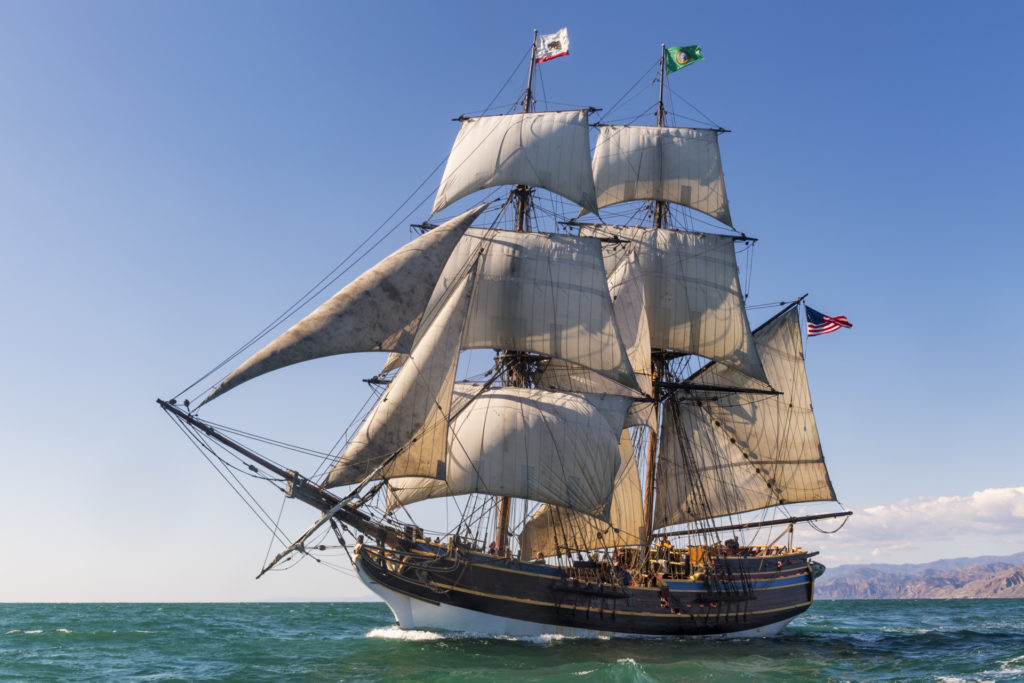
Photograph of the brig Lady Washington, which sails on the West Coast. This vessel is the same size and rig as Stanton Hazard’s King George
Argo, closely followed by King George, was brought into New London with great rejoicing and celebrations. According to a family biography, as he expected, Hazard found that the committee of judges who were to rule on his fate were all old friends of his, some of them even related. They did not feel comfortable in having their friend locked up indefinitely, and they were pondering what to do when Hazard suggested the perfect solution. He asked to be sent to Narragansett on his parole, to the house of his sister (the wife of another cousin, Dr. Robert Hazard). He promised that he would not leave the house and gardens until he was properly exchanged for a prisoner held by the Americans. Hazard kept his promise faithfully.
The story is told that one morning Hazard spotted a travel-stained sailor lurching past the gate. He hailed the man and asked if he were hungry. When the man said that he was indeed hungry, Hazard invited him into the house and gave him a plentiful breakfast. Then he asked the sailor if he had any money, and when the sailor showed that his pockets were entirely empty, Hazard showed the sailor that his own pockets contained only two silver dollars. “This is all the money I have,” he said, “but I will divide it with you.” He gave the sailor one of the dollars, and then walked with him as far as the gate, saying, “I can go no farther. My word of honor keeps me inside this gate.”
Stanton Hazard was eventually released in a prisoner exchange. In the meantime, two and a half months after Hazard’s capture, British General Sir Henry Clinton ordered the evacuation of all British forces from Newport and from Rhode Island. The evacuation was completed on October 26, 1779; one rogue officer failed to obey orders and burned the lighthouse at Beavertail Point in Jamestown. The question has often been asked: why would the British abandon the finest naval harbor in North America? The answer may be that Congress had received in March 1779 an offer, relayed by Clinton from the British Cabinet, of complete independence with no strings attached. The British understandably did not want to have to fight the French and Spanish, and the best way to accomplish that was to give the Americans what they wanted. Clinton’s evacuation of Newport may therefore have been a confidence-building measure to reinforce with Congress the seriousness of the British offer. As it happened, Congress turned down the offer for other reasons, and the war dragged on for an additional four years. The Rhode Island that Hazard was released to had no British authorities remaining in place, so he quietly went about his business in the state in his old haunts.
After the war was over, at age 42, Hazard married Elizabeth Wickham on July 3, 1785. The couple had only one child, who died in infancy. When the Napoleonic Wars erupted in the 1790s, Hazard saw his opportunity to rejoin the Royal Navy. He obtained an officer’s commission (or was about to), but he died shortly afterwards in British Honduras (Belize): he died from an infected stab wound suffered in a sword duel a few days earlier, in which he killed his adversary outright. Elizabeth lived until September 22, 1801.
Silas Talbot, for his part, was hired to command John Brown’s Rhode Island 20-gun privateer frigate General Washington, but was quickly captured. Talbot soon found himself a prisoner of war in the Mill Prison in England for much of the rest of the war, but after the war he was made one of the first captains of the new U.S. frigate Constitution for a year.
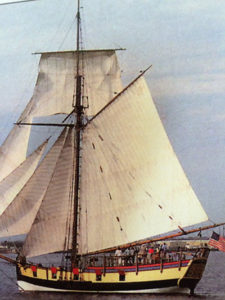
Replica of the Continental sloop Providence. The author was the driving force behind his construction, completed in 1976 (John Millar)
But, what about the brig formerly named King George? Investors at New London purchased her after she was condemned by the court. She was renamed Allegiance, and sent out to sea under American colors, stopping only long enough make simple repairs to the point-blank cannon damage, and to repaint the figurehead so that it no longer looked like George III. After only a few days at sea, she was captured by a Loyalist privateer out of New York City. She was converted into a Loyalist privateer under the same name, but her new owners decided to re-rig her as a full-rigged ship by adding a mizzen mast. She had a successful career for the rest of the war.
At one point, Allegiance was accompanying some other ships in the waters north of Nova Scotia when she encountered the powerful 34-gun French frigate L’Hermione (pronounced “Lair-me-unn”), which was unable to catch her. (Author’s Note: a full-size reproduction of L’Hermione was recently built at Rochefort, France, and in 2015 she visited ports along the East Coast from Yorktown, Virginia to Louisbourg, Nova Scotia (including Newport, Rhode Island), with great acclaim. Rochefort officials were inspired to begin the 17-year process to build the ship when the full-size operational copy of the smaller 20 gun frigate Rose, built by the author in 1970, visited the French port in 1996.)
An officer on the original French frigate made a sketch of Allegiance from a distance, and described her as a 20-gun frigate. The addition of the mizzen mast had made her appear much larger than she really was! No doubt she was sailed to England after the war. The peace treaty ending the war specifically stated that peaceable Loyalists were to be permitted to remain in the United States if they so wished, but New York refused to abide by those terms and tried to rid itself of all former residents who were Loyalists. Allegiance’s owner could therefore not have stayed in New York even if he had wanted to do so.
[Banner image: Photograph of the brig Lady Washington, which sails on the West Coast. This vessel is the same size and rig as Stanton Hazard’s King George]

